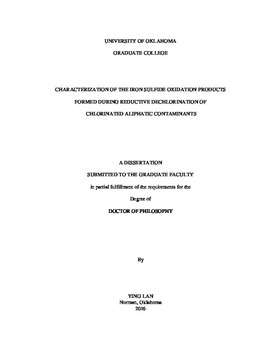| dc.description.abstract | The overarching objective of this research is to investigate the transformation of iron sulfide, mackinawite (FeS), in contaminated environments. A special research focus is to investigate the FeS oxidation products formed during dechlorination of tetrachloroethylene (PCE), trichloroethylene (TCE) and carbon tetrachloride (CT). The results from this research will enhance the ability to effectively apply FeS in the in situ remediation of contaminated sites by chlorinated aliphatic contaminants.
The transformation of powdered FeS to greigite (Fe3S4) and pyrite (FeS2) under geochemical conditions similar to those in pristine or contaminated aquifers was monitored. To observe the transformation without altering or damaging the crystal structures, FeS particles were immobilized on poly(methyl methacrylate) (PMMA) supports, and mineralogical changes were monitored by scanning electron microscopy with energy dispersive X-ray spectroscopy (SEM/EDS). Powders of FeS immobilized on PMMA supports were placed in aqueous solutions containing polysulfides and mildly elevated temperatures (75-78 oC) to promote the transformation to greigite and pyrite. SEM/EDS results were consistent with previously reported X-ray diffraction (XRD) analysis that showed the transformation of mackinawite to greigite and pyrite. The similarities in sizes between most crystals over the course of the transformation from mackinawite to pyrite, as well as the coexistence of solids with morphologies and elemental compositions characteristic of mackinawite, greigite, and pyrite, are consistent with a solid state transformation. In some cases, however, much smaller pyrite crystals were formed, which may have resulted from direct nucleation from solution. The results reported here extend the applicability of PMMA supports for studying mineralogical transformations to particles with dimensions from 100 nm to 2 µm, and to elevated temperatures. Such supports can be used to monitor iron-sulfur mineralogical changes in pristine and contaminated environments. The FeS oxidation products formed during the reaction between FeS and CT at pH 7 and 8 were studied. XRD analysis suggested the formation of greigite upon reaction of FeS with CT at pH 7. At pH 8, reaction of FeS with CT led to the formation of abundant spherical particles with diameters between 50-400 nm on the FeS surface and in solution; far fewer such particles were observed at pH 7. Analysis of the FeS surface by EDS after reaction with CT at pH 8 showed decreased sulfur and elevated oxygen compared to unreacted FeS. The spherical particles that formed upon FeS reaction with CT were mostly amorphous with localized areas of poorly crystalline two-line ferrihydrite. X-ray photoelectron spectroscopy (XPS) indicated that the predominant Fe surface species after reaction with CT at pH 8 was Fe(III)-O, consistent with ferrihydrite and other amorphous iron (hydr)oxides as major products. No oxidation of sulfide was observed. The oxidation products of FeS during reaction with TCE and PCE at pH 8 were also investigated. Results indicated that the FeS oxidation products by TCE
and PCE were mainly greigite, and non-crystalline iron (hydr)oxides might be another possible product. S species on the FeS surface were oxidized during the dechlorination of TCE and PCE by FeS, while no oxidation of Fe species was observed within the time frame of the study.
This research provides direct evidence for the FeS oxidation products formed during dechlorination of CT, TCE, and PCE using FeS. Both ferrihydrite and Fe+2, which is a product of greigite dissolution, can react with dissolved HS- to form FeS, suggesting that, after oxidation by chlorinated aliphatic contaminants, FeS can be regenerated by addition or microbial generation of sulfide. | en_US |
